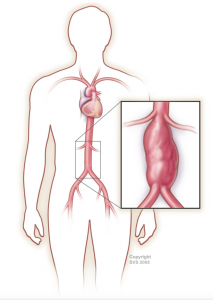
Vascular and Vein Surgery
What is abdominal aortic aneurysm? 
Your arteries deliver oxygen-rich blood from your heart to other parts of your body. The aorta, the largest artery in your body, runs from your heart, down through your chest, and into your abdomen (called the abdominal region). The abdominal region of the aorta is responsible for delivering blood to your legs, GI tract, and kidneys. An abdominal aortic aneurysm (AAA) occurs when the wall of the aorta progressively weakens and begins to bulge. An AAA may continue to enlarge and eventually rupture if left untreated, causing severe internal bleeding and possibly death.
In addition to concerns about rupture, clots or debris may also develop within an AAA. These substances can be carried to other areas in the body and block circulation, causing severe pain or possibly limb loss if blood flow is cut off for too long.
AAA can be safely treated with early diagnosis. Nearly 200,000 people in the United States are diagnosed with AAA annually; approximately 15,000 die each year from a ruptured AAA.
Causes and risk factors
Most aortic aneurysms are caused by a breakdown in the proteins that provide structural strength to the wall of the aorta. Some risk factors that contribute to this structural breakdown include:
Symptoms
Most people feel no symptoms, and an AAA is often detected when tests are conducted for other unrelated reasons. Those with symptoms describe them as:
• A pulsing feeling in their abdomen
• Unexplained, severe pain in their abdomen or lower back
• Pain, discoloration, or sores on their feet (this is a rare symptom)
• Age—individuals over 60 years are most likely to develop the condition
• Gender—males are more prone to the condition than females
• History of atherosclerosis (hardening of the arteries)
• Family history of AAA
• Smoking
• High blood pressure
• Chronic lung disease
Diagnosis
If you experience symptoms of AAA, or if unrelated tests reveal AAA may be present, see a vascular surgeon. They are the only physicians treating vascular disease today who can perform all the treatment options available, including medical management, minimally invasive endovascular stent graft procedures, or open AAA repair. Only when you see a vascular surgeon who can perform all potential treatments will you be assured of receiving the care that is most appropriate to your condition.
Medicare Screening Benefit
Medicare offers a free, one-time AAA ultrasound screening for qualified seniors as part of their Welcome to Medicare physical during the first 12 months of their enrollment. Men who have smoked sometime during their life and men and women with a family history of AAA are eligible for this benefit.
Treatment
The most important factor determining the treatment of AAA is its size. It may require lifestyle changes, such as quitting smoking, lowering blood pressure, and taking medication. For large AAAs, or those that have been increasing in size over time, repair may be carried out either by placement of an endovascular stent graft or by open bypass grafting. Your vascular surgeon will diagnose and prescribe the best treatment for your condition.

